Abstract
Acute myeloid leukemia (AML) cells are relatively resistant to tumor necrosis factor α–related apoptosis-inducing ligand (TRAIL). We previously reported that triptolide, a potent anticancer agent from a Chinese herb, decreases XIAP in leukemic cells. We evaluated the combination of triptolide and TRAIL and found synergistic promotion of apoptosis in AML cells. XIAP-overexpressing U937 cells (U937XIAP) were more resistant to TRAIL than U937neo cells, and inhibition of XIAP with the small-molecule inhibitor 1396-11 enhanced TRAIL-induced apoptosis, implying XIAP as a resistance factor in AML. Furthermore, triptolide increased DR5 levels in OCI-AML3, while the DR5 increase was blunted in p53-knockdown OCI-AML3 and p53-mutated U937 cells, confirming a role for p53 in the regulation of DR5. In support of this finding, disruption of MDM2-p53 binding with subsequent increase in p53 levels by nutlin3a increased DR5 levels and sensitized OCI-AML3 cells to TRAIL. The combination of 1396-11 plus nutlin3a plus TRAIL was more effective than either the 1396-11 and TRAIL or nutlin3a and TRAIL combinations in OCI-AML3 cells, further supporting the role of triptolide as a sensitizer to TRAILinduced apoptosis in part by independent modulation of XIAP expression and p53 signaling. Thus, the combination of triptolide and TRAIL may provide a novel strategy for treating AML by overcoming critical mechanisms of apoptosis resistance.
Introduction
In spite of great efforts in the past 30 years, the outcome for patients with acute myeloid leukemia (AML) remains poor, with a 5-year survival rate of about 20%.1 The development of novel and effective therapies is thus urgently needed
Tumor necrosis factor α–related apoptosis-inducing ligand (TRAIL) has received great attention in recent years as a potential treatment for a variety of hematologic and nonhematologic malignancies.2-4 Indeed, TRAIL and agonistic anti-TRAIL receptor DR4 and DR5 antibodies have been found to be selectively cytotoxic to a wide variety of human tumor cells in vitro and in vivo.5-8 Based on these promising preclinical observations, TRAIL (Genentech, South San Francisco, CA) as well as agonistic anti-DR4 and anti-DR5 antibodies (Human Genome Sciences, Rockville, MD) have recently entered clinical trials. However, primary AML cells are relatively resistant to TRAIL.9-12 Given the potential of TRAIL, it is important to identify means of overcoming this resistance.
We and others have recently reported that triptolide, a diterpenoid isolated from the Chinese herb Tripterygium wilfordii Hook.f, a member of the Celastraceae family of plants, has potent antitumor properties by suppressing cell growth and inducing apoptosis in a broad range of human tumor cells and leukemias.13-18 Triptolide has also been shown to sensitize various solid tumor cells19-22 to TRAIL-induced cell death. Although triptolide was found to sensitize lung cancer cells to TRAIL-induced apoptosis by NF-κB inhibition,21,23,24 the mechanisms underlying sensitization are not well understood, and their relevance to leukemias has not been investigated.
XIAP, a potent cellular caspase inhibitor, is an important resistance factor in TRAIL-induced cell death. Down-regulation or indirect inhibition of XIAP potentiates TRAIL-induced tumor cell death.25-28 XIAP is highly expressed in various leukemic cell lines and blasts from AML patient samples,29-31 and is a potential target for AML therapy.31,32 We recently reported that triptolide potently induces apoptosis in both leukemia cell lines and in primary AML patient samples, in part by decreasing XIAP levels.18 On the basis of these observations, we hypothesized that triptolide may overcome or alleviate TRAIL resistance in leukemic cells by decreasing XIAP levels.
TRAIL exerts its activity by binding to and activating death receptors. Lack of or defects in the expression of death receptors can lead to TRAIL resistance. The expression of death receptor DR5 is regulated by p53.33-35 Even though the TP53 gene mutation is infrequent in human leukemia, its negative cellular regulator MDM2 (murine double minute 2) is frequently overexpressed in AML, and can enhance the tumorigenic potential and resistance to apoptosis.36-39 Disrupting the p53-MDM2 interaction by the recently identified MDM2 antagonist nutlin3a40 was found by us to induce p53-dependent apoptosis in AML, suggesting a novel therapeutic strategy for patients with AML whose cells are harboring wild-type (wt) p53.41 Interestingly, triptolide was reported to increase the expression of p53.42,43 However, the role of p53 activation induced by triptolide in TRAIL sensitization has not been characterized.
In the study reported here, we therefore investigated whether triptolide could sensitize AML cells to TRAIL-induced apoptosis and the possible mechanisms of this effect. We here report that triptolide greatly enhanced TRAIL-induced apoptosis at least in part via decreases in XIAP and by p53-mediated increases in DR5 levels in AML cells.
Methods
Cells and cell cultures
OCI-AML3, OCI-AML3vec, OCI-AML3p53shRNA, U937, U937neo, and U937XIAP cells were cultured in RPMI 1640 medium supplemented with 10% heat-inactivated fetal calf serum (FCS), 2 mM l-glutamine, 100 U/mL penicillin, and 100 μg/mL streptomycin. U937 cells were purchased from the American Type Culture Collection (Manassas, VA). OCI-AML3 cells were kindly provided by Dr M. Minden (Ontario Cancer Institute, Toronto, ON). U937 cells overexpressing XIAP (U937XIAP) and the vector control cells (U937neo) were kind gifts of Dr D. Kufe (Dana-Farber Cancer Institute, Harvard Medical School, Boston, MA).44 Fresh primary AML patient samples with high blast counts were acquired after informed consent had been obtained according to institutional guidelines and the declaration of Helsinki. Mononuclear cells were purified by Ficoll-Hypaque (Sigma Chemical, St Louis, MO) density-gradient centrifugation and cultured in RPMI 1640 medium supplemented with 10% FCS. The clinical characteristics of these samples are summarized in Table 1.
Clinical characteristics of patients with AML
| Patient . | Sample source . | Blasts, % . | Cytogenetics . | Treatment and responses at the time of sampling . |
|---|---|---|---|---|
| 1 | BM | 89 | 46,XX | Prior CR with idarubicin + Ara-C, relapse |
| 2 | BM | 91 | 46,XY, del(12)(p11.2p13)[7],46,XY,t(2;5)(p11.2;q11.2), del(16)(q13)[3],46,XY,del(3)(q21q27),add(12)(p13),add(22)(q13)[3], 46,XY,der(17)t(11;17)(q12;p11.1)[2],46,XY,del(6)(p21.1p25), del(12)(p11.2p13),add(17)(p11.1) [1],46,XY[2] | Prior CR with idarubicin + Ara-C, relapse, prior CR with decitabine, relapse, resistant to troxacitabine and 5-azacitidine |
| 3 | BM | 83 | 46,XX, inv(16)(p13.1q22) | Newly diagnosed, no treatment |
| 4 | PB | 58 | 46,XX | Newly diagnosed, no treatment |
| 5 | PB | 76 | 46,XX, del(6)(p23), add(14)(p11.2) | Achieved CR with clofarabine and low-dose Ara-C then relapsed |
| 6 | PB | 84 | 45,XY, −7 | Prior CR with clofarabine and low-dose Ara-C, relapse |
| 7 | BM | 77 | 46,XY[30] | Resistant to MGCD-0103 + azacytidine |
| 8 | PB | 66 | 46,XX,t(5;7)(q34;p13)[17],46,XX,t(1;8)(p22;q22)[1],46,XX[2] | Prior CR with idarubicin + Ara C, relapse; prior CR with Mylotarg, relapse |
| 9 | BM | 81 | 46,XX[20] | Newly diagnosed, no treatment |
| 10 | BM | 91 | 45,XY,del(3q),−7 [12] | Newly diagnosed, no treatment |
| 11 | PB | 63 | 46,XY[20] | Newly diagnosed, no treatment |
| 12 | PB | 85 | 46,XY,t(9;11)(p22;q23)[20] | Newly diagnosed, no treatment |
| Patient . | Sample source . | Blasts, % . | Cytogenetics . | Treatment and responses at the time of sampling . |
|---|---|---|---|---|
| 1 | BM | 89 | 46,XX | Prior CR with idarubicin + Ara-C, relapse |
| 2 | BM | 91 | 46,XY, del(12)(p11.2p13)[7],46,XY,t(2;5)(p11.2;q11.2), del(16)(q13)[3],46,XY,del(3)(q21q27),add(12)(p13),add(22)(q13)[3], 46,XY,der(17)t(11;17)(q12;p11.1)[2],46,XY,del(6)(p21.1p25), del(12)(p11.2p13),add(17)(p11.1) [1],46,XY[2] | Prior CR with idarubicin + Ara-C, relapse, prior CR with decitabine, relapse, resistant to troxacitabine and 5-azacitidine |
| 3 | BM | 83 | 46,XX, inv(16)(p13.1q22) | Newly diagnosed, no treatment |
| 4 | PB | 58 | 46,XX | Newly diagnosed, no treatment |
| 5 | PB | 76 | 46,XX, del(6)(p23), add(14)(p11.2) | Achieved CR with clofarabine and low-dose Ara-C then relapsed |
| 6 | PB | 84 | 45,XY, −7 | Prior CR with clofarabine and low-dose Ara-C, relapse |
| 7 | BM | 77 | 46,XY[30] | Resistant to MGCD-0103 + azacytidine |
| 8 | PB | 66 | 46,XX,t(5;7)(q34;p13)[17],46,XX,t(1;8)(p22;q22)[1],46,XX[2] | Prior CR with idarubicin + Ara C, relapse; prior CR with Mylotarg, relapse |
| 9 | BM | 81 | 46,XX[20] | Newly diagnosed, no treatment |
| 10 | BM | 91 | 45,XY,del(3q),−7 [12] | Newly diagnosed, no treatment |
| 11 | PB | 63 | 46,XY[20] | Newly diagnosed, no treatment |
| 12 | PB | 85 | 46,XY,t(9;11)(p22;q23)[20] | Newly diagnosed, no treatment |
CR indicates complete remission.
Generation of p53-knockdown OCI-AML3 (OCI-AML3p53shRNA) cells
Retrovirus was prepared by transfecting pCMV_8.2, the vesicular stomatitis virus envelope plasmid pMD.G, and the green fluorescent protein (GFP)–expressing gene transfer plasmid or the plasmid encoding a short hairpin RNA (shRNA) against human p53 (kindly provided by Dr M. Soengas, University of Michigan, Ann Arbor, MI)45 into 293T cells with lipofectamine following the manufacturer's instructions (Invitrogen, Carlsbad, CA). The shRNA sequence is shown as follows with both sense (bolded) and antisense (italic and bolded) sequences for p53: 5′-CCCGACTCCAGTGGTAATCTACTTCAAGAGAGTAGATTACCACTGGAGTCTTT-3′.
OCI-AML3 cells, 2 × 105/well, were seeded in a 6-well plate. A total of 1 mL of virus containing supernatant was added to each well. Cells were infected for 30 minutes and spin-inoculated at 1200g at room temperature. After spin-inoculation, medium was replaced by fresh RPMI 1640 with 10% FCS, and cells were incubated for 48 hours at 37°C in an atmosphere containing 5% CO2. Cells were then sorted by GFP fluorescence to obtain OCI-AML3vec control cells and p53-knockdown OCI-AML3p53shRNA cells. The silencing of p53 in OCI-AML3 cells was confirmed by Western blotting.
Treatment of cells
Exponentially growing cells (0.2 × 106/mL) or mononuclear cells from AML patients (0.5 × 106/mL) were treated with various concentrations of triptolide, TRAIL (both purchased from Alexis Biochemicals, San Diego, CA), the MDM2 inhibitor nutlin3a, or the XIAP inhibitor 1396-11 (Torrey Pines Institute for Molecular Studies, La Jolla, CA)46 for 24 or 48 hours. An appropriate amount of DMSO (≤ 0.1%) was used as a control. For the multiple combination studies, 0.2 mL of exponentially growing cells (0.4 × 106/mL) or mononuclear cells from patients with AML (0.5 × 106/mL) was placed in 96-well plates, and cells were treated with a combination of increasing concentrations of various agents at a fixed ratio for 24 or 48 hours.
Cell viability assay
Cell viability was determined by trypan blue exclusion using a Vi-Cell XR Cell Counter (Beckman Coulter, Fullerton, CA). Apoptosis was estimated by flow cytometry measurements of phosphatidyl serine47 externalization with the annexin V–FLUOS staining kit (Roche Diagnostics, Indianapolis, IN) using a FACSCalibur (BD Biosciences, Franklin Lakes, NJ). Membrane integrity was simultaneously assessed by propidium iodide (PI) exclusion in the annexin V–stained cells. For the combination studies, treated cells were stained with annexin V in conjunction with the vital dye 7-amino-actinomycin D (AAD) in a 96-well plate and analyzed using a FACSArray Bioanalyzer (BD Biosciences). To eliminate the variation from spontaneous apoptosis in AML patient samples, the apoptosis measured in these samples is expressed as specific apoptosis: (% apoptosis in treated cells − % apoptosis in untreated cells) ÷ % viable cells in untreated cells.
Western blot analysis
Western blot analysis to determine the levels of various proteins was performed as described previously.31 Briefly, treated cells were washed with phosphate-buffered saline (PBS) and lysed in protein lysis buffer (0.25 M Tris-HCl, 2% SDS, 4% β-mercaptoethanol, 10% glycerol, and 0.02% bromophenol blue). An equal amount of cell lysate was loaded onto a 12% SDS-PAGE gel (Bio-Rad, Hercules, CA). After incubation with the second antibody, the membranes were reacted with ECL solution (GE Healthcare, Little Chalfont, United Kingdom). Signals were detected by a PhosphorImager (Storm 860 Version 4.0; Molecular Dynamics, Sunnyvale, CA) and quantified by Scion Image software (Scion, Frederick, MD). β-actin was included as a loading control.
Statistical analyses
All experiments were conducted 3 times, and results were expressed as means plus or minus SE, unless otherwise stated. The IC50 (ie, the concentration of an agent that induced annexin V positivity in 50% of cells) was calculated using Calcusyn software (Biosoft, Ferguson, MO). The combination index (CI) was determined by the Chou-Talalay method48 and Calcusyn software and was expressed as the average of the CI values obtained at the ED50, ED75, and ED90. A CI of less than 1 was considered synergistic, a CI of 1 was considered additive, and a CI of greater than 1 antagonistic.
Results
Triptolide synergistically enhances TRAIL-induced cell death in various leukemia cells
To test whether triptolide enhances TRAIL-induced cell death in AML cells, we treated OCI-AML3 and U937 cells with various concentrations of triptolide, TRAIL, or both agents. As illustrated in Figure 1, OCI-AML3 and U937 cells were relatively resistant to TRAIL at the concentrations used; however, apoptosis was greatly enhanced when triptolide, at very low concentrations, was combined with TRAIL, with a CI of 0.41 plus or minus 0.017 for OCI-AML3 and a CI of 0.50 plus or minus 0.186 for U937 cells, indicating a synergistic effect.
Triptolide synergistically enhances TRAIL-induced cell death in leukemic cells. OCI-AML3 and U937 cells were treated with TRAIL, triptolide, or both agents. Cell death was determined by annexin V/PI staining at 48 hours (CI-1). Error bars represent SE.
Triptolide synergistically enhances TRAIL-induced cell death in leukemic cells. OCI-AML3 and U937 cells were treated with TRAIL, triptolide, or both agents. Cell death was determined by annexin V/PI staining at 48 hours (CI-1). Error bars represent SE.
XIAP is a resistance factor for TRAIL-induced cell death in leukemic cells
To determine the role of XIAP in TRAIL resistance of leukemic cells, we treated XIAP-overexpressing U937 cells (U937XIAP) and control cells (U937neo) with TRAIL and compared their responses. As shown in Figure 2, U937XIAP cells were approximately 8-fold more resistant to TRAIL (IC50 = 51.89 ± 11.97 ng/mL) than were U937neo cells (IC50 = 6.63 ± 0.57 ng/mL). TRAIL or triptolide alone, as shown in Figure 3, decreased the XIAP protein levels in U937neo cells. However, each alone did not significantly change XIAP levels in U937XIAP cells. When the cells were treated with both triptolide and TRAIL, a much greater decrease in XIAP protein levels was detected in both cells, an effect accompanied by a significantly increased cell death in both U937neo (CI = 0.59 ± 0.13) and U937XIAP cells (CI = 0.25 ± 0.03; Figure 3). At the higher triptolide/TRAIL concentrations (10 nM/15 ng/mL and 15 nM/22.5 ng/mL), the decreases in XIAP levels and increases in cell death were comparable between U937neo and U937XIAP cells. However, at the lower triptolide/TRAIL concentration (5 nM/7.5 ng/mL), the relative decrease in XIAP levels was significantly higher in U937neo than in U939XIAP cells, probably related to the much higher basal level of XIAP in U937XIAP cells. Of note, U937neo cells were more sensitive to TRAIL than U937 cells (Figures 2,3 compared with Figure 1). XIAP levels in U937neo cells were found to be lower than in U937 cells, thus further supporting the notion that XIAP levels affect TRAIL sensitivity and resistance (results not shown).
XIAP-overexpressing U937 cells (U937XIAP) are more resistant than the control cells (U937neo) to TRAIL-induced cell death. U937neo and U937XIAP cells were treated with TRAIL for 48 hours, and cell death was measured by annexin V/PI staining. Error bars represent SE.
XIAP-overexpressing U937 cells (U937XIAP) are more resistant than the control cells (U937neo) to TRAIL-induced cell death. U937neo and U937XIAP cells were treated with TRAIL for 48 hours, and cell death was measured by annexin V/PI staining. Error bars represent SE.
Triptolide decreases XIAP protein levels and sensitizes both U937neo and U937XIAP cells to TRAIL-induced cell death. U937neo and U937XIAP cells were treated with TRAIL, triptolide, or both agents for 48 hours. XIAP protein levels were determined by Western blotting and cell death by annexin V/PI staining and flow cytometric analysis. Error bars represent SE.
Triptolide decreases XIAP protein levels and sensitizes both U937neo and U937XIAP cells to TRAIL-induced cell death. U937neo and U937XIAP cells were treated with TRAIL, triptolide, or both agents for 48 hours. XIAP protein levels were determined by Western blotting and cell death by annexin V/PI staining and flow cytometric analysis. Error bars represent SE.
We then treated both cell lines with TRAIL in the presence of the small-molecule XIAP inhibitor 1396-11. 1396-11 is a polyphenylurea-based small-molecule XIAP antagonist that binds to BIR2 of XIAP and promotes caspase-dependent apoptosis.32,46 At 3 μM, 1396-11 had no significant effect on the survival of either U937neo or U939XIAP cells. However, when combined with TRAIL, 1396-11 augmented TRAIL-induced cell death in both U937neo (IC50 = 3.18 ± 0.77 ng/mL with 1396-11 vs IC50 = 6.63 ± 0.57 ng/mL without 1396-11) and U939XIAP cells (IC50 = 14.81 ± 1.30 ng/mL with 1396-11 vs IC50 = 51.89 ± 11.97 ng/mL without 1396-11). These results indicate that the overexpression of XIAP diminishes and the inhibition of XIAP enhances TRAIL-induced apoptosis, suggesting that triptolide sensitizes TRAIL, at least in part, by decreasing XIAP levels.
Triptolide activates p53 signaling and induces expression of the p53 downstream target DR5
To fully explore the synergistic effect of triptolide on TRAIL-induced cell death in leukemia, we treated OCI-AML3 and U937 cells with triptolide and examined TRAIL receptor DR5 levels by Western blotting. As shown in Figure 4, triptolide significantly increased DR5 levels in OCI-AML3 cells, which contain wt p53, but increased DR5 levels to a much lesser extent in U937 cells, which have mutated p53 (Figure 4A). We therefore examined p53 expression in triptolide-treated cells. This showed that triptolide increased p53 protein levels in OCI-AML3 cells while, as expected, no p53 was detected in U937 cells (Figure 4B). The p53 antibody used for these studies (p53 [FL-393] sc-6243; Santa Cruz Biotechnology, Santa Cruz, CA) did not detect the mutated form of p53 in U937 cells. Next, we treated p53-knockdown OCI-AML3 cells (OCI-AML3p53shRNA) and their controls (OCI-AML3vec) with triptolide, which confirmed the induction of p53 and DR5 expression in OCI-AML3vec cells, while no induction of p53 was detected and the increase in DR5 expression was partly inhibited in OCI-AML3p53shRNA cells (Figure 4C), supporting our observation that triptolide activates p53 signaling and induces the p53 downstream target DR5, thus sensitizing AML cells to TRAIL.
Triptolide activates p53 signaling and induces the expression of the p53 downstream target DR5. OCI-AML3 and U937 cells were treated with triptolide for 48 hours. DR5 (A) and p53 (B) levels were determined by Western blotting. OCI-AML3vec and OCI-AML3p53shRNA cells were treated with triptolide for 48 hours. p53 and DR5 protein levels (C) were measured by Western blotting.
Triptolide activates p53 signaling and induces the expression of the p53 downstream target DR5. OCI-AML3 and U937 cells were treated with triptolide for 48 hours. DR5 (A) and p53 (B) levels were determined by Western blotting. OCI-AML3vec and OCI-AML3p53shRNA cells were treated with triptolide for 48 hours. p53 and DR5 protein levels (C) were measured by Western blotting.
DR5 induction by activation of p53 signaling enhances TRAIL-induced apoptosis in AML cells
To confirm that p53-mediated DR5 activation indeed plays a role in enhancing TRAIL-induced apoptosis in AML cells, we treated OCI-AML3 cells with the selective MDM2 inhibitor nutlin3a. As demonstrated in Figure 5, nutlin3a activated p53, increased DR5 protein levels, and synergistically enhanced cell death induced by TRAIL (CI = 0.058 ± 0.004). To further demonstrate that the activation of p53 by nutlin3a produces a pronounced synergistic effect, we compared the viability of OCI-AML3vec and OCI-AML3p53shRNA cells treated with nutlin3a, TRAIL, or both. Nutlin3a activated p53 and increased DR5 levels in the OCI-AML3vec control cells, while p53 was only minimally activated and DR5 levels only slightly increased in p53-knockdown OCI-AML3p53shRNA cells (Figure 6). Thus, OCI-AML3vec cells were sensitive, while OCI-AML3p53shRNA cells were resistant to nutlin3a (Figure 6, solid and open circle lines, respectively). Both cells had a similar weak response to TRAIL (Figure 6; solid and open triangle lines, respectively). However, TRAIL-induced cell death was significantly enhanced by nutlin3a in OCI-AML3vec cells, but only slightly in OCI-AML3p53shRNA cells (Figure 6, solid and open square lines, respectively). Our results strongly suggest that triptolide augments TRAIL, at least in part, by increasing DR5, which is mediated by p53 activation.
Activation of p53 by the MDM2-specific inhibitor nutlin3a induces DR5 expression and sensitizes cells to TRAIL-induced cell death. OCI-AML3 cells were treated with nutlin3a, TRAIL, or nutlin3a plus TRAIL for 24 hours. p53 and DR5 protein levels were measured by Western blotting and cell death by annexin V/PI staining and flow cytometric analysis. N3a indicates nutlin3a; TR, TRAIL. Error bars represent SE.
Activation of p53 by the MDM2-specific inhibitor nutlin3a induces DR5 expression and sensitizes cells to TRAIL-induced cell death. OCI-AML3 cells were treated with nutlin3a, TRAIL, or nutlin3a plus TRAIL for 24 hours. p53 and DR5 protein levels were measured by Western blotting and cell death by annexin V/PI staining and flow cytometric analysis. N3a indicates nutlin3a; TR, TRAIL. Error bars represent SE.
Sensitization to TRAIL-induced cell death and induction of DR5 expression by nutlin3a are significantly diminished in p53-knockdown cells. OCI-AML3vec and OCI-AML3p53shRNA cells were treated with TRAIL, nutlin3a, or both agents. p53 and DR5 protein levels were determined by Western blotting and cell death was determined by annexin V/PI staining at 24 hours. Solid lines with solid marks represent OCI-AML3vec cells, and dashed lines with open marks represent OCI-AML3p53shRNA cells. Error bars represent SE.
Sensitization to TRAIL-induced cell death and induction of DR5 expression by nutlin3a are significantly diminished in p53-knockdown cells. OCI-AML3vec and OCI-AML3p53shRNA cells were treated with TRAIL, nutlin3a, or both agents. p53 and DR5 protein levels were determined by Western blotting and cell death was determined by annexin V/PI staining at 24 hours. Solid lines with solid marks represent OCI-AML3vec cells, and dashed lines with open marks represent OCI-AML3p53shRNA cells. Error bars represent SE.
Simultaneous inhibition of XIAP and activation of p53 further sensitizes leukemic cells to TRAIL-induced apoptosis
Since these results demonstrated that triptolide decreases XIAP levels and increases DR5 levels mediated by p53 activation, and that these 2 events independently sensitize leukemic cells to TRAIL-induced cell death, we predicted that the simultaneous inhibition of XIAP and activation of p53 would further sensitize leukemic cells to TRAIL-induced cell death. To test this hypothesis, OCI-AML3 cells were treated with combinations of 1396-11 plus TRAIL, nutlin3a plus TRAIL, and 1396-11 plus nutlin3a plus TRAIL for 24 hours. At the concentrations used, TRAIL, 1396-11, or nutlin3a alone was not very effective in inducing cell death (Figure 7). The combination of XIAP inhibitor and TRAIL (1396-11 + TRAIL) or MDM2 inhibitor and TRAIL (nutlin3a + TRAIL) synergistically induced cell death (CI = 0.168 ± 0.055 and CI = 0.058 ± 0.004, respectively). When the 3 agents were combined, cell death was further enhanced. The triple combination (CI = 0.044 ± 0.006) was more effective in inducing cell death than either 1396-11 and TRAIL or nutlin3a and TRAIL combinations (Figure 7). These results further support the notion that triptolide sensitizes AML cells to TRAIL-induced cell death by modulating both XIAP expression and p53 signaling.
Simultaneous inhibition of XIAP and activation of p53 improves sensitization of AML cells to TRAIL-induced cell killing. OCI-AML3 cells were treated with TRAIL, 1396-11, nutlin3a, TRAIL plus 1396-11, TRAIL plus nutlin3a, or TRAIL plus 1396-11 and nutlin3a for 24 hours. Cell death was assessed by annexin V/PI staining. N3a indicates nutlin3a; TR, TRAIL. Error bars represent SE.
Simultaneous inhibition of XIAP and activation of p53 improves sensitization of AML cells to TRAIL-induced cell killing. OCI-AML3 cells were treated with TRAIL, 1396-11, nutlin3a, TRAIL plus 1396-11, TRAIL plus nutlin3a, or TRAIL plus 1396-11 and nutlin3a for 24 hours. Cell death was assessed by annexin V/PI staining. N3a indicates nutlin3a; TR, TRAIL. Error bars represent SE.
Triptolide sensitizes AML blasts to TRAIL-induced apoptosis
When blasts from the bone marrow (BM) or peripheral blood (PB) of 12 patients with AML (Table 1) were exposed to TRAIL, only very little apoptosis was induced in all samples, even at 100 ng/mL (Figure 8), underscoring the fact that AML blasts are in general insensitive to TRAIL as monotherapy. However, when TRAIL was combined with triptolide, sensitization of primary AML blasts to TRAIL was observed in 8 of 12 samples tested (Table 2, patients 2, 4, 5, 7-11 bold type; Figure 8). For patient 6, although the CI is greater than 1, the 2 drugs were synergistic at ED75 and ED90 (Table 2).
Treatment of blasts from AML patient samples with a combination of triptolide and TRAIL. Cell death was assessed by annexin V/AAD staining at 24 hours. The graph includes only the patient samples with a CI less than 1 (n = 8). Error bars represent SE.
Treatment of blasts from AML patient samples with a combination of triptolide and TRAIL. Cell death was assessed by annexin V/AAD staining at 24 hours. The graph includes only the patient samples with a CI less than 1 (n = 8). Error bars represent SE.
CI values of AML samples treated with triptolide and TRAIL in vitro
| Patient . | CI values . | Average . | |||
|---|---|---|---|---|---|
| ED50 . | ED75 . | ED90 . | CI . | SEM . | |
| 1 | 1.42 | 1.52 | 1.64 | 1.52 | 0.06 |
| 2 | 0.37 | 0.18 | 0.10 | 0.22 | 0.08 |
| 3 | 42.76 | 5.32 | 7.35 | 18.48 | 12.15 |
| 4 | 1.11 | 0.69 | 0.44 | 0.74 | 0.20 |
| 5 | 0.36 | 0.20 | 0.12 | 0.23 | 0.07 |
| 6 | 18.27 | 0.59 | 0.55 | 6.47 | 5.90 |
| 7 | 0.68 | 0.08 | 0.02 | 0.26 | 0.21 |
| 8 | 0.30 | 0.07 | 0.02 | 0.13 | 0.09 |
| 9 | 0.64 | 0.44 | 0.30 | 0.46 | 0.10 |
| 10 | 0.79 | 0.72 | 0.66 | 0.72 | 0.04 |
| 11 | 0.79 | 0.71 | 0.63 | 0.71 | 0.05 |
| 12 | 202.89 | 1.06 | 0.95 | 68.30 | 67.29 |
| Patient . | CI values . | Average . | |||
|---|---|---|---|---|---|
| ED50 . | ED75 . | ED90 . | CI . | SEM . | |
| 1 | 1.42 | 1.52 | 1.64 | 1.52 | 0.06 |
| 2 | 0.37 | 0.18 | 0.10 | 0.22 | 0.08 |
| 3 | 42.76 | 5.32 | 7.35 | 18.48 | 12.15 |
| 4 | 1.11 | 0.69 | 0.44 | 0.74 | 0.20 |
| 5 | 0.36 | 0.20 | 0.12 | 0.23 | 0.07 |
| 6 | 18.27 | 0.59 | 0.55 | 6.47 | 5.90 |
| 7 | 0.68 | 0.08 | 0.02 | 0.26 | 0.21 |
| 8 | 0.30 | 0.07 | 0.02 | 0.13 | 0.09 |
| 9 | 0.64 | 0.44 | 0.30 | 0.46 | 0.10 |
| 10 | 0.79 | 0.72 | 0.66 | 0.72 | 0.04 |
| 11 | 0.79 | 0.71 | 0.63 | 0.71 | 0.05 |
| 12 | 202.89 | 1.06 | 0.95 | 68.30 | 67.29 |
Bold type indicates samples showing synergistic effect (CI <1).
Discussion
In this study, we demonstrated that triptolide sensitizes AML cells from both cell lines and primary blasts of patients to TRAIL-induced apoptosis, at least in part via a decrease in XIAP levels and a p53-mediated increase in DR5 levels.
We showed previously that triptolide decreases XIAP and by itself potently induces cell death at low nanomolar concentrations. Here, we report that triptolide induces p53 expression in AML cells. Its ability to sensitize AML cells to TRAIL-induced cell death and alleviate TRAIL resistance by decreasing XIAP and increasing DR5 via activation of p53 lends added support for the further development of triptolide for AML therapy. Since p53 activates the expression of several death receptors, we believe triptolide induces increases in both the DR5 and DR4 protein levels in AML cells.
It is known that the activation of p53 increases MDM2 expression via a feedback loop.49,50 We observed in the present study that triptolide seems to activate p53 by decreasing the MDM2 levels (results not shown). In this regard, triptolide may be more effective than nutlin3a in stabilizing p53 and activating p53 signaling. Although the mechanism employed by triptolide to reduce MDM2 levels is not clear, our preliminary studies have suggested that triptolide functions as a transcription inhibitor (B.Z.C., unpublished results, November 2005). As a consequence, the levels of short-lived proteins such as XIAP and MDM2 decreased. In support of this possibility, flavopiridol was observed to induce chronic lymphocytic leukemia (CLL) cell death through the transcriptional inhibition of both XIAP and Mcl-1.51 Triptolide also increases p53 levels by enhancing p53 protein translation.42,43
We observed a slight increase in DR5 levels in TP53-mutated U937 cells treated with triptolide, suggesting that triptolide also induces p53-independent up-regulation of DR5. Such induction of DR5 via p53-independent mechanisms has also been reported for other systems.52,53 The moderate increase in DR5 levels in nutlin3a-treated p53-knockdown OCI-AML3p53shRNA cells seen in the present study could be due to residual p53, and the increase in DR5 levels in triptolide-treated p53 knockdown OCI-AML3p53shRNA cells could be attributed to the combination effect of the p53-independent up-regulation of DR5 and residual p53.
We showed that triptolide or TRAIL alone decreased XIAP levels in U937neo but had almost no effect on U937XIAP cells. Triptolide in combination with TRAIL greatly decreased XIAP levels, probably as a result of enhanced activation of caspases and induction of apoptosis. Since XIAP protein levels are still very high in U937XIAP cells treated with triptolide/TRAIL at 5 nM/7.5 ng/mL, and yet triptolide still enhances killing at this concentration almost as well as in U937neo cells, the results may suggest that triptolide also kills via XIAP-independent mechanisms. The ability of triptolide to inhibit NF-κB21,23,24 and decrease Mcl-118 could be part of the mechanisms.
Among the 12 primary AML blast samples analyzed, synergistic effects of triptolide and TRAIL were observed in 8, suggesting the potential clinical relevance of this finding. It is important to point out that, in addition to the overexpression of XIAP and a lack of p53 signaling, a dysfunction of DR4 and DR5, a defect in any components of the extrinsic apoptotic cascade,54-57 the overexpression of antiapoptotic Bcl-2 and loss of function of proapoptotic Bcl-2 proteins,58-60 and the activation of mitogen-activated protein kinase (MAPK)61 or NF-κB signaling62,63 can all contribute to TRAIL resistance. Therefore, it is difficult to single out which particular protein or set of proteins results in diminished or absent sensitization to the combination. Nevertheless, in vitro treatment of AML blasts with triptolide and TRAIL may help to predict the clinical responses to this combination.
It was reported that PG490-88, a water-soluble derivative of triptolide, at 0.25 mg/kg markedly decreased tumor growth, and at 0.5- and 0.75-mg/kg doses caused profound tumor regression without apparent toxicities in nude mouse human tumor xenograft models.64 A decrease in white blood cells was reported in clinical trials with triptolide or extracts of Tripterygium wilfordii.65,66 A phase 1 clinical trial with a water-soluble derivative of triptolide in solid tumors is presently ongoing in France. Results have not been reported. A phase 1 study of recombinant TRAIL in patients with advanced cancers showed that it is safe and well tolerated up to 15 mg/kg.67 The safety and effectiveness of the triptolide/TRAIL combination in AML can only be determined in clinical trials. Given the fact that triptolide potently induces death of AML blasts regardless of their clinical response to chemotherapies18 and enhances TRAIL in most of the samples studied in vitro, and that both agents are clinically tolerable, we expect that the combination of triptolide and TRAIL could be beneficial to patients with AML who are resistant or intolerant to standard chemotherapy.
Collectively, the findings from the present study suggest that inhibition of XIAP and induction of DR5 mediated by p53 activation independently sensitize AML cells to TRAIL-induced apoptosis. We observed that triptolide not only inhibits XIAP, which is overexpressed in AML and contributes to the resistance to TRAIL and various chemotherapeutic agents, but also activates p53 signaling, which is intact in the majority of AMLs and promotes apoptosis through multiple mechanisms, including the activation of death receptors. Thus, the combination of triptolide and TRAIL may constitute a novel concept in the treatment of AML by overcoming critical mechanisms of apoptosis resistance, which could be further enhanced by nongenotoxic p53 activation.
The publication costs of this article were defrayed in part by page charge payment. Therefore, and solely to indicate this fact, this article is hereby marked “advertisement” in accordance with 18 USC section 1734.
Acknowledgments
We would like to thank Dr Maria S. Soengas for providing us with p53shRNA, Elena S. Vess and Betty L. Notzon for helping with the manuscript preparation, and Wenjing Chen for collecting patient information.
This study was supported in part by grants from the National Institutes of Health (P01 CA49639, P01 CA55164, and CA16672) to M.A.
National Institutes of Health
Authorship
Contribution: B.Z.C. designed and performed the experiments, and wrote the paper; D.H.M., W.D.S., and M.F.D. performed experiments; C.P., L.T.V., and J.R. provided reagents andvaluable suggestions; and M.A. suggested experiments and reviewed the paper.
Conflict-of-interest disclosure: The authors declare no competing financial interests.
Correspondence: Michael Andreeff, Section of Molecular Hematology and Therapy, Department of Stem Cell Trans-plantation and Cellular Therapy, Unit 448, The University of Texas, M. D. Anderson Cancer Center, 1515 Holcombe Blvd, Houston, TX 77030; e-mail: mandreef@jmdanderson.org.

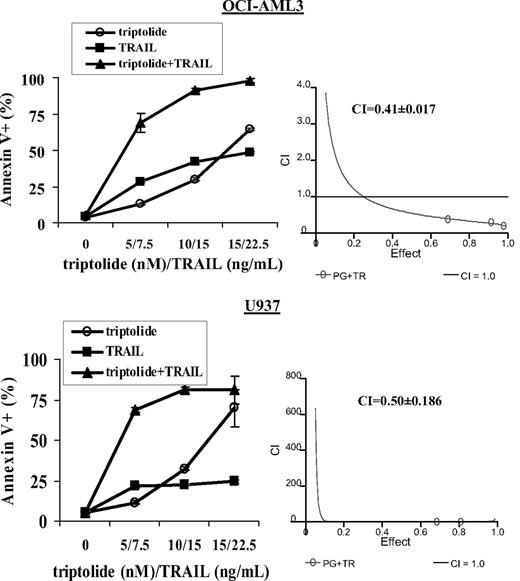

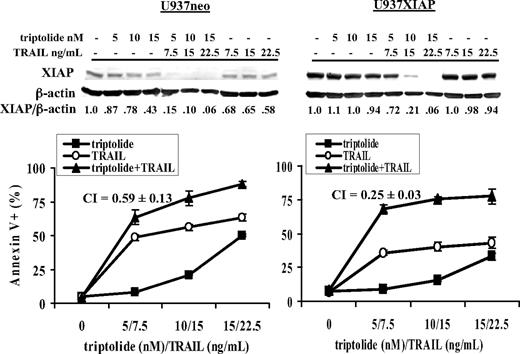
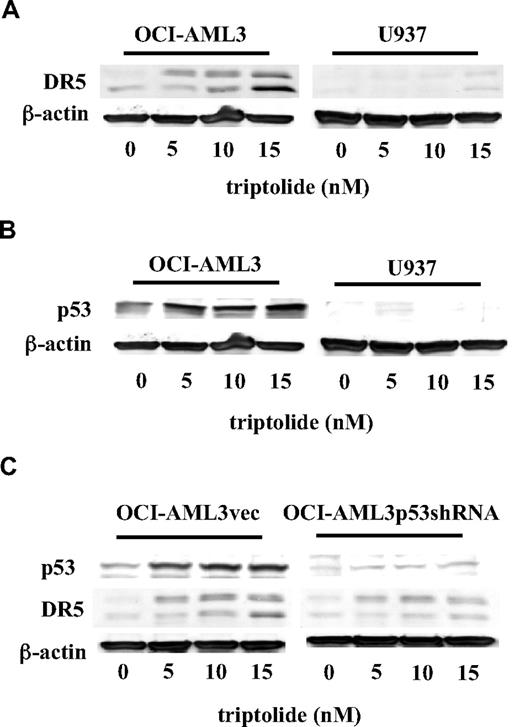
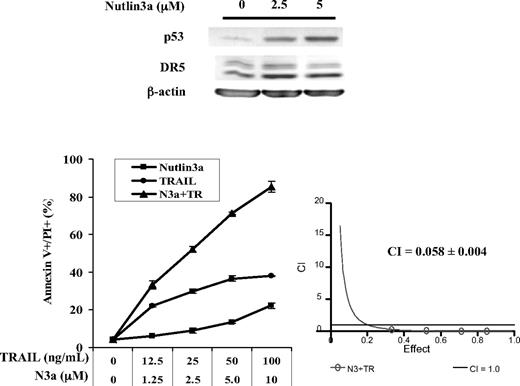
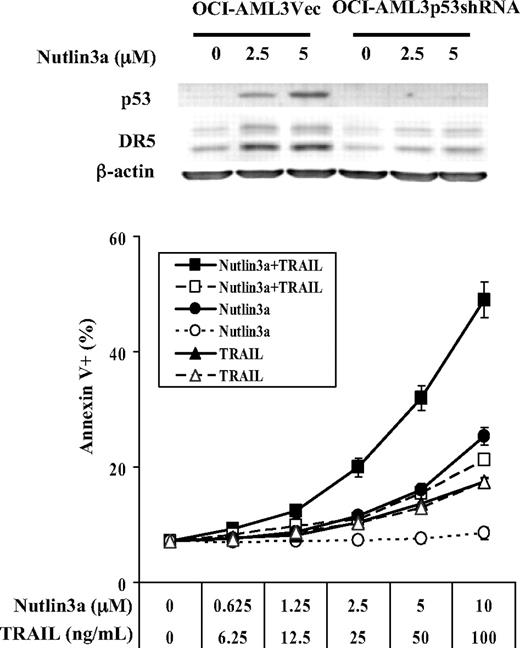

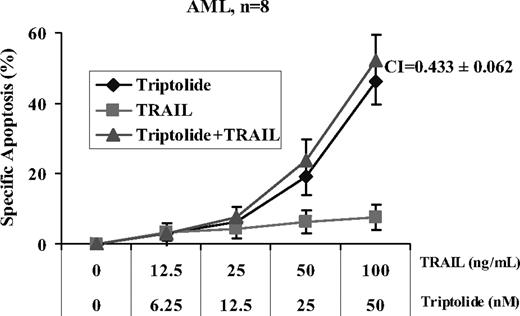
This feature is available to Subscribers Only
Sign In or Create an Account Close Modal